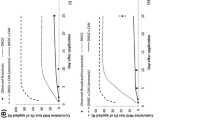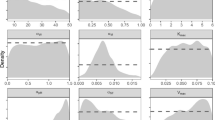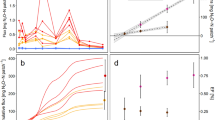Abstract
Urea concentrations in urine patches deposited during animal grazing can be over ten times higher than typical fertiliser application rates, potentially leading to large ammonia (NH3) losses. The process-based NZ-DNDC model was modified to better simulate soil pH changes and ammonia (NH3) emissions following urine application using data collected from a New Zealand field trial. After modification, simulated 30-day NH3 emissions decreased from 506 to 117 kg N ha−1 compared to measured emissions of 78 ± 3 kg N ha−1 (mean ± standard error) and the Nash–Sutcliffe Efficiency (NSE) for daily NH3 emissions increased from −7.11 to +0.97 for the parameterisation dataset. However, modified model correctly estimated the cumulative emissions for the first 7 days. Using the same parameterisation on an independent dataset from a nearby site gave cumulative 18-day NH3 emissions of 84 kg N ha−1 compared to the measured 48 ± 2 kg N ha−1 (mean ± standard error). However, the NSE for daily NH3 emissions was −0.71, indicating site specific parameterisation might be needed. The sensitivity of NH3 emissions to ±5 and ±10% errors in 4 model parameters was tested. The sensitivities ranged from −0.36 to +0.71. The highest sensitivity was to the rate of NH3 transfer from the soil solution to the atmosphere and the lowest sensitivity was to the rate of urea hydrolysis.



Similar content being viewed by others
References
Congreves KA, Grant BB, Dutta B, Smith WN, Chantigny MH, Rochette P, Desjardins RL (2016) Predicting ammonia volatilization after field application of swine slurry: DNDC model development. Agric Ecosyst Environ 219:179–189
Dutta B, Congreves KA, Smith WN, Grant BB, Rochette P, Chantigny MH, Desjardins RL (2016) Improving DNDC model to estimate ammonia loss from urea fertilizer application from urea fertilizer application in temperate agroecosystems. Nutr Cycl Agroecosyst 106:275–292
Gilhespy SL, Anthony S, Cardenas L, Chadwick D, del Prado A, Li C, Misselbrook T, Rees RM, Salas W, Sanz-Cobena A, Smith P, Tilston EL, Topp CFE, Vetter S, Yeluripati JB (2014) First 20 years of DNDC (DeNitrification DeComposition): model evolution. Ecol Model 292:51–62
Giltrap DL, Li C, Saggar S (2010a) DNDC: a process-based model of greenhouse gas fluxes from agricultural soils. Agric Ecosyst Environ 136:292–300
Giltrap DL, Singh J, Saggar S, Zaman M (2010b) A preliminary study to model the effects of a nitrification inhibitor on nitrous oxide emissions from urine-amended pasture. Agric Ecosyst Environ 136:310–317
Giltrap D, Rodriguez J, Berben P, Palmada T, Saggar S (2015a) Modelling NH3 volatilisation from a urine patch and urea application using NZ-DNDC. In: Currie LD, Burkitt LL (eds) Moving farm systems to improved attenuation. http://flrc.massey.ac.nz/publications.html. Occasional Report No. 28. Fertilizer and Lime Research Centre, Massey University, Palmerston North, New Zealand
Giltrap DL, Vogeler I, Cichota R, Luo J, van der Weerden TJ, de Klein CAM (2015b) Comparison between APSIM and NZ-DNDC models when describing N-dynamics under urine patches. N Z J Agric Res 58(2):131–155
Haynes WM, Lide DR, Bruno TJ (eds) (2012) CRC handbook of chemistry and physics, 93rd edn. CRC Press, Cleveland
Keating B, Carberry P, Hammer G, Probert M, Robertson N, Holzworth D (2003) An overview of APSIM, a model designed for farming system simulation. Eur J Agron 18:276–288
Kissel DE, Brewer HL, Arkin GF (1977) Design and test of a field sampler for ammonia volatilisation. Soil Sci Soc Am J 41:1133–1138
Laubach J, Taghizadeh-Toosi A, Sherlock RR, Kelliher FM (2012) Measuring and modelling ammonia emissions from a regular pattern of cattle urine patches. Agric For Meteorol 156:1–17
Li C, Frolking S, Frolking TA (1992) A model of nitrous oxide evolution from soil driven by rainfall events: 1. Model structure and sensitivity. J Geophys Res 97(D9):9759–9776
Li C, Salas W, Zhang R, Krauter C, Rotz A, Mitloehner F (2012) Manure-DNDC: a biogeochemical process model for quantifying greenhouse gas and ammonia emissions from livestock manure systems. Nutr Cycl Agroecosyst 93:163–200
Móring A, Vieno M, Doherty RM, Laubach J, Taghizadeh-Toosi A, Sutton MA (2016) A process-based model for ammonia emission from urine patches, GAG (Generation of Ammonia from Grazing): description and sensitivity analysis. Biogeosciences 13:1837–1861
Nash JE, Sutcliffe JV (1970) River flow forecasting through conceptual models. I. A discussion of principles. J Hydrol 10:282–290
Rodriguez J (2014) Effect of application times of urease (Agrotain) on NH3 emissions from urine patches. M.Sc. thesis, Massey University, Palmerston North
Saggar S, Andrew RM, Tate KR, Hedley CB, Rodda NJ, Townsend JA (2004) Modelling nitrous oxide emissions from dairy-grazed pastures. Nutr Cycl Agroecosyst 68:243–255
Saggar S, Giltrap DL, Li C, Tate KR (2007) Modelling nitrous oxide emissions from grazed grasslands in New Zealand. Agric Ecosyst Environ 119:205–216
Sherlock RR, Goh KM (1984) Dynamics of ammonia volatilization from simulated urine patches and aqueous urea applied to pasture. I. Field experiments. Fertil Res 5:181–195
Sherlock RR, Goh KM (1985a) Dynamics of ammonia volatilization from simulated urine patches and aqueous urea applied to pasture. II. Theoretical derivation of a simplified model. Fertil Res 6:3–22
Sherlock RR, Goh KM (1985b) Dynamics of ammonia volatilization from simulated urine patches and aqueous urea applied to pasture. III. Field verification of a simplified model. Fertil Res 6:23–36
Sherlock R, Jewell P, Clough T (2008) Review of New Zealand specific FRACGASM and FRACGASF emission factors. MAF Technical Paper No. 2011/32. Wellington, Ministry of Agriculture and Forestry
Singh J, Saggar S, Giltrap DL, Bolan NS (2008) Decomposition of dicyandiamide (DCD) in three contrasting soils and its effect on nitrous oxide emissions, soil respiratory activity, and microbial biomass—an incubation study. Aust J Soil Res 46:517–525
Snoek DJW, Stigter JD, Ogink NWM, Groot Koerkamp PWG (2014) Sensitivity analysis of mechanistic models for estimating ammonia emissions from dairy cow urine puddles. Biosyst Eng 121:12–24
Acknowledgements
This research was supported by Core funding for Crown Research Institutes from the Ministry of Business, Innovation and Employment’s Science and Innovation Group. The data used in these simulations were from experimental work funded by Ballance-Agrinutrients and the New Zealand Agricultural Greenhouse Gas Research Centre. Thanks to Peter Berben and Thilak Palmada for their contribution to the experimental work, to Johannes Laubach and anonymous reviewers for helpful comments on early drafts, and to Anne Austin for editing.
Author information
Authors and Affiliations
Corresponding author
Rights and permissions
About this article
Cite this article
Giltrap, D., Saggar, S., Rodriguez, J. et al. Modelling NH3 volatilisation within a urine patch using NZ-DNDC. Nutr Cycl Agroecosyst 108, 267–277 (2017). https://doi.org/10.1007/s10705-017-9854-x
Received:
Accepted:
Published:
Issue Date:
DOI: https://doi.org/10.1007/s10705-017-9854-x




